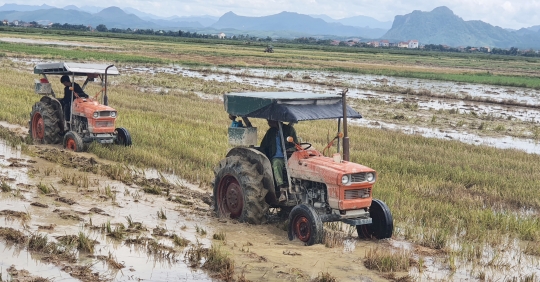We went to the large field of Hoanh Vinh Cooperative (An Ninh Township, Quang Ninh District, Quang Binh). The 300+ hectare field is laid out in large checkerboard fields with solid and wide vertical and horizontal streets. Mr. Vo Doan Duc, director of the cooperative, said: “We must have this plan to ensure that all motorized vehicles can reach the foot of the field even though it is almost ten kilometers away.”

Many towns in Quang Binh have 100% mechanized the land preparation phase. Picture: Tam Phung.
Many years ago in the field tillage for the entire area was mechanized. After that, the harvesting phase was also mechanized. The harvest hand ran close to the road, dumped the round sacks of rice and was loaded into the car and drove to the alley. Since 2021, the Hoanh Vinh Cooperative has been sending planes to spray pesticides and planting machines on the fields. The peasants welcomed it.
Mr. Vo Doan Thuan has 3 hectares of rice fields with two harvests per year and a yield of over 70 quintals/ha. Mr. Thuan said, “All tillage is now essentially mechanized, so the soil is more mature and fine. In agriculture, farmers have saved costs, e.g. B. by reducing varieties, reducing pesticides and reducing labor. Therefore, each hectare of field increased the profit from VND 10 to 15 million per year.”
In recent years, communities in Ba Don city have not only focused on crop restructuring, but also increased application and mechanized agricultural production, which has brought many positive results.

The first planting machine was used in the field of Quang Ninh District. Picture: Tam Phung.
Mr. Nguyen Van Khanh, head of the economic department of Ba Don city, said that the traditional agricultural phases in the city have almost disappeared. “People have mechanized production, the tillage mechanization rate has reached 100%, the harvesting stage has reached over 95%. By 2022, the whole city will have more than 3,100 agricultural machines of all kinds. Some places in the city have used the technology of spraying herbicides for rice using unmanned aerial vehicles (drones),” Khanh said.
Since the beginning of 2022, the Song Gianh Corporation Joint Stock Company has applied the flight technology to more than 200 hectares of rice for chain linking. According to Mr. Dang Thai Vu, director of the company’s plant seed factory, the use of pesticide spraying drones in agricultural production has helped lower production costs, reduce the amount of medicine and protect people’s health.
“Spraying 5 ha of rice with a hand sprayer takes more than 50 hours. Meanwhile, spraying by drone only takes 1.5 hours; The total amount of drug with the drone is only 0.5 kg, while traditional spraying with a handheld sprayer is 1 kg. In particular, all used medicine bottles are collected and taken to a prescribed place for treatment and are not released into the environment. The production process does not affect the health of farmers,” said Mr. Vu.

Combine harvester in the territory of the Le Thuy district. Picture: Tam Phung.
In order to facilitate the application of synchronous mechanization in agricultural production, the Le Thuy district has actively encouraged households and collective economy models to boldly invest in appropriate machinery, promote the work of land consolidation.
Mr. Nguyen Van Hoang’s family (Phong Thuy Municipality, Le Thuy District) owns 3 hectares of dual crop paddy fields. Before, his family would spend more than tens of millions of dongs every harvest to hire people to harvest. There are years, the rice is ripe in the field, but still no reaper, so worried and sick.
“Today the family’s rice harvest was easier. Harvesting occurs quickly, which not only saves time and labor, but also significantly reduces costs. In addition, quick harvest also avoids risks from natural disasters that affect the productivity and quality of agricultural products,” said Mr. Hoang.
Mr. Nguyen Huu Han, vice chairman of the Le Thuy District People’s Committee, said, “We promote and support the linkage of production and consumption of agricultural products. The application of mechanization in production has helped to reduce farmers’ labor, overcome the shortage of seasonal workers, reduce the time for tillage, sowing and harvesting, save costs and increase productivity, increase profitability and in particular to contribute to the reduction of post-harvest losses”.

